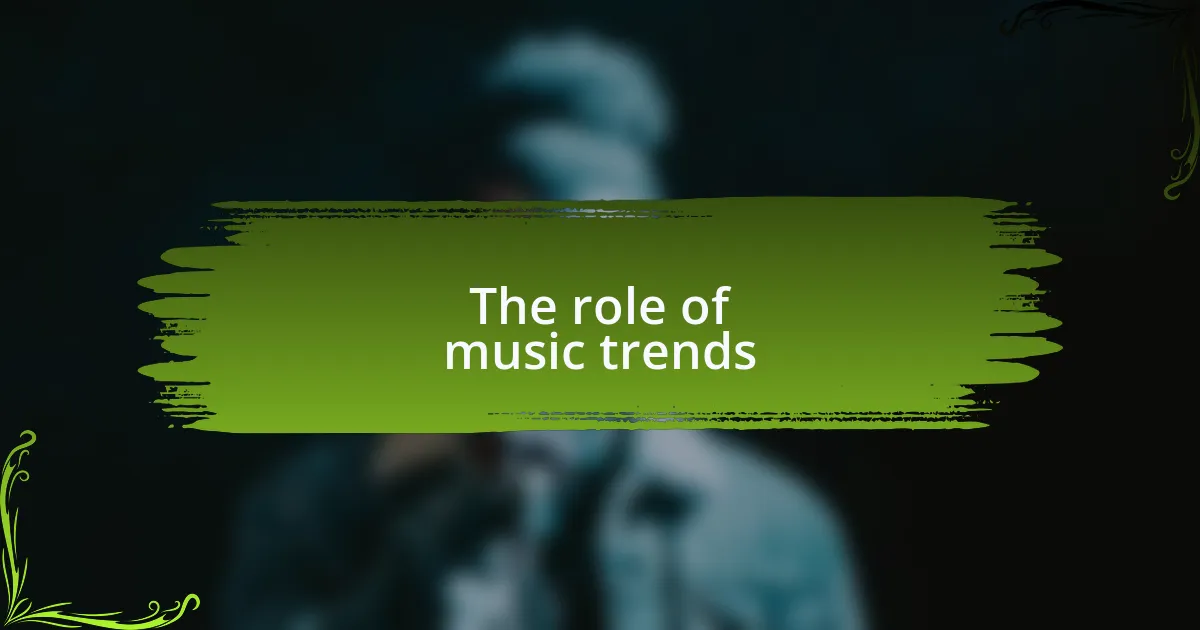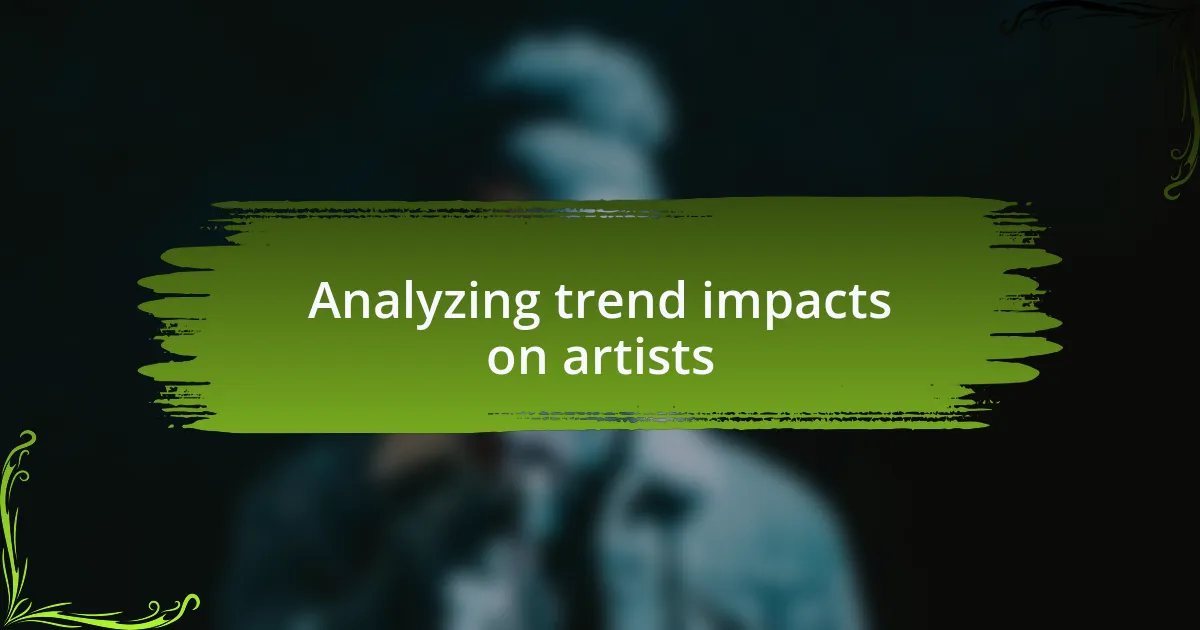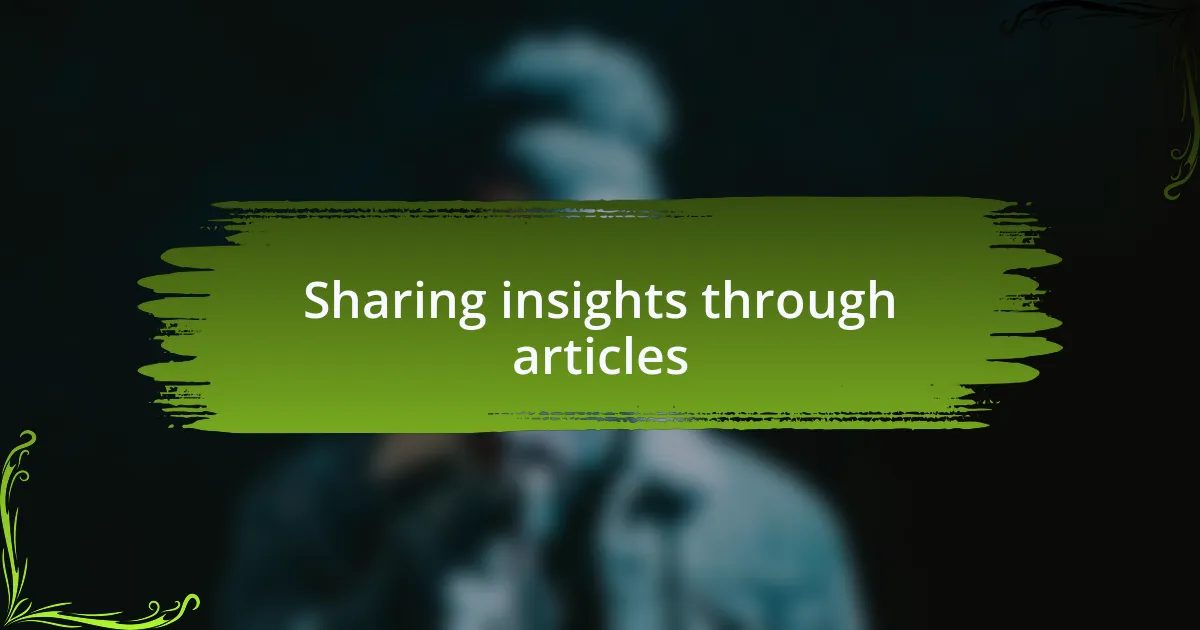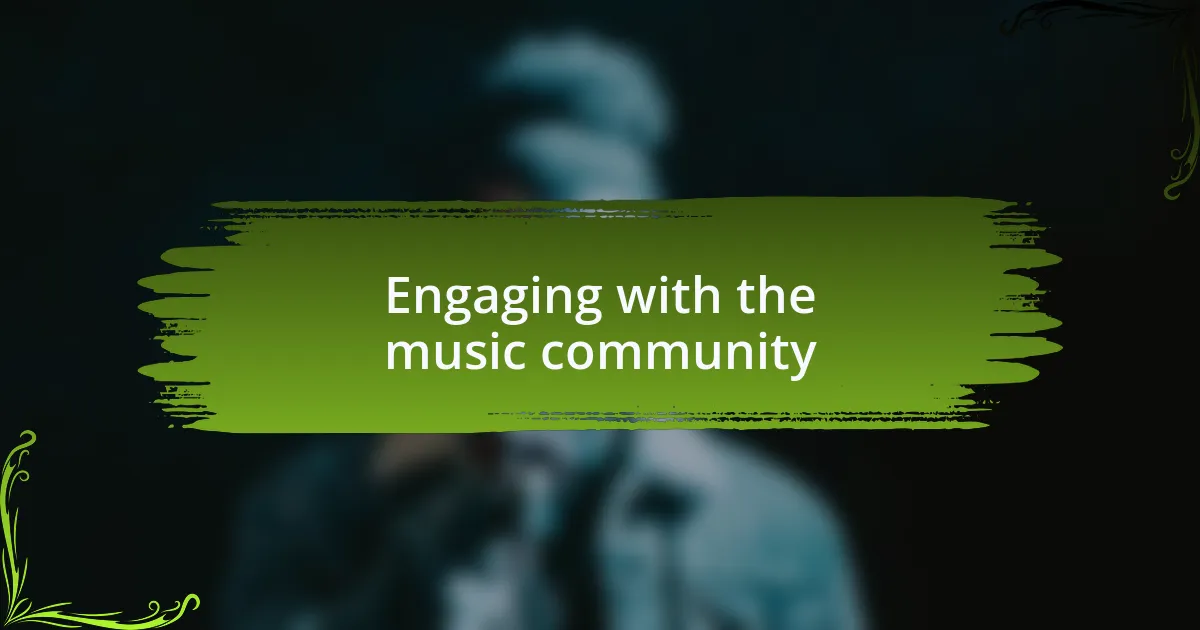Key takeaways:
- Music journalism is rooted in storytelling, requiring authenticity and context to enrich listener appreciation.
- Trends in music reflect societal moods and values, serving as a catalyst for artistic innovation and community building.
- Researching trends involves utilizing platforms like social media and music publications to understand audience connections and genre evolution.
- Engaging with the music community fosters meaningful connections and enhances the depth of journalism through shared experiences and conversations.

Understanding music journalism principles
At its core, music journalism revolves around storytelling. I remember attending a local music festival and hearing an artist share their journey through a song. It struck me how powerful narratives can connect audiences to music on a deeper level. Have you ever felt that tug when a lyric resonates with your own experiences? That’s the magic of good storytelling in music journalism.
Another principle that’s often overlooked is the responsibility of a music journalist to provide context. I once wrote about an emerging band and felt compelled to explore their influences and the cultural backdrop of their sound. By highlighting these elements, I enriched the listener’s appreciation and understanding. It’s not just about the music; it’s about the world surrounding it, wouldn’t you agree?
Authenticity is a principle that I hold dear in my work. When I wrote a review of a friend’s album, I made sure my impressions were genuine, reflecting both the highs and lows. Readers can sense when something isn’t authentic, and they appreciate honesty. Have you noticed how reviews that resonate often share a real connection to the music? This is what elevates music journalism from mere reporting to a heartfelt discussion.

The role of music trends
The role of music trends is both dynamic and influential in shaping how audiences engage with sound. I recall a time when I found myself captivated by the rapid rise of lo-fi hip-hop. It wasn’t just the chill beats; it was the entire culture exploding on platforms like YouTube that drew listeners into a new realm of relaxation and creativity. It made me wonder: how do these trends cultivate communities and change the music landscape?
As I navigated these shifts, I recognized that music trends often serve as a reflection of societal moods and values. For example, when I explored the resurgence of punk-inspired sounds, it was clear that they resonated with a generation eager for change. That connection sparked deep conversations in my community; have you ever felt that a genre suddenly became relevant because it spoke to the times we live in?
In my experience, trends can create fertile ground for innovation as artists experiment with new styles and genres. I remember interviewing a local musician who blended elements of electronic and traditional folk music. It was thrilling to see how he drew inspiration from current trends while respecting his roots. Isn’t it fascinating how the evolution of music often intertwines with the very fabric of cultural expression?

Researching current music trends
Researching current music trends requires digging deep into various sources. I’ve found that platforms like Spotify and TikTok are treasure troves of information. When I was sifting through playlists, I noticed how certain tracks would consistently pop up. It got me thinking: what makes these songs resonate so universally right now?
Beyond streaming platforms, social media serves as a powerful lens into emerging trends. Once, I spent an evening scrolling through Instagram reels, capturing snippets of indie artists who were gaining traction. These clips often showcased raw and authentic moments, inviting me to wonder: how does authenticity in artist expression drive audience connection? Each artist seemed to echo a shared sentiment, making their music not just a product, but a collective experience.
Then there’s the wealth of music publications and blogs that dissect the landscape. As I read various articles, I’ve come across insightful commentary on genre evolution and artist collaborations. One piece I stumbled upon discussed the rise of genre-blurring artists, which triggered a personal reflection on how my musical tastes have shifted. Have you ever felt pulled in different directions by diverse sounds and styles? Understanding these dynamics has fundamentally changed how I approach music journalism.

Analyzing trend impacts on artists
Trends can have a profound impact on artists, shaping their sound, image, and even their fan interactions. When I attended a music festival last summer, I noticed how many performers tailored their sets to align with current trends, infusing pop elements into their traditionally indie styles. This leaves me pondering: to what extent do artists sacrifice their authenticity for commercial success?
Moreover, social media trends often dictate the pace at which artists must release music. I recall speaking with a friend who manages an up-and-coming band. They felt immense pressure to produce singles rapidly, in fear of getting lost in the noise. It made me realize that while trends can elevate an artist’s visibility, they can also lead to a frenetic work pace that risks burnout. How do artists maintain their creative integrity amidst such demands?
Furthermore, I’ve observed that collaborations across genres are more prevalent than ever, often fueled by viral trends. Recently, I watched a documentary featuring an artist who acknowledged that blending styles not only helped her reach new audiences but also allowed her to explore her artistic range. This illustrates a vital question in the industry: are artists now more experimental because of trends, or are trends merely reflecting a broader shift in artistic exploration?

Developing a personal music voice
Finding your personal music voice is a journey that blends self-discovery with external influences. I remember when I first started writing music reviews; I was caught up in what everyone expected but soon realized that my unique perspective is what truly resonates with readers. It’s essential to embrace what makes you different, as authenticity in your voice can forge deeper connections with your audience.
As I experimented with different styles of music and writing, I learned that developing a musical identity is often a blend of influences and personal experiences. Reflecting on my teenage years, I found solace and expression in punk rock, which shaped much of my initial writing. How does your own background in music inform your voice? Identifying those elements can add a rich layer to your work, inviting your audience into your unique musical world.
I often advise fellow music journalists to let their emotions guide their writing. For instance, when I wrote about a local band that spoke to my own experiences with heartbreak, my passion seemed to leap off the page. Readers connect with honesty. So, how can you channel your feelings into your music voice? It’s about weaving your story into the narrative, making your reflections resonate and inviting others on the same emotional journey.

Sharing insights through articles
Sharing insights through articles is one of the most rewarding aspects of music journalism. I recall an article I wrote dissecting the impact of a particular genre on contemporary artists. While doing the research, I stumbled upon stories from both musicians and fans that highlighted the genre’s transformative power. That merging of perspectives not only enriched my writing but also created a vibrant conversation with my readers.
As I pen down my thoughts, I often wonder how much my insights can spark a discussion or inspire someone else. For example, after I wrote about the resurgence of vinyl records, readers shared their own nostalgic experiences with record collecting, turning an article into a communal reflection on music’s history. It reinforced my belief that articles can be a springboard for deeper exploration into collective memories and modern interpretations.
Moreover, I find that sharing personal anecdotes within my articles resonates deeply with readers. When I opened up about the first concert that moved me, I noticed a wave of responses detailing similar experiences. There’s something powerful about vulnerability in writing; it cultivates a sense of trust that draws readers closer. Have you ever considered how your personal stories could enhance your articles and foster connection? After all, music is a shared journey, and our insights can lead others to realize they’re not alone in their musical affinities.

Engaging with the music community
Engaging with the music community goes beyond simply writing articles; it’s about creating meaningful connections with both artists and fans. I vividly recall attending a local music festival, where I had the chance to chat with emerging artists between sets. Their passion and stories brought a new depth to my understanding of the music they create, and I found that sharing these insights with my readers allowed them to feel closer to the artists.
When I interact on social media platforms, I often ask questions to spark conversations around recent releases or trends. Just the other day, I inquired about people’s thoughts on the latest album from a favorite band. The responses poured in, revealing not only personal preferences but also varied interpretations of the music. It struck me how these dialogues create a sense of community, allowing fans to unite around shared experiences and differing opinions. Have you ever considered how your questions could foster discussions that strengthen those bonds?
Moreover, attending local open mic nights has become a staple for me. I’ve met countless aspiring musicians eager to share their journeys and struggles. One evening, a young performer shared how her struggle with anxiety influenced her songwriting. Her story reminded me of my own challenges in expressing vulnerability through my work. Engaging with these artists humanizes the music, reminding both me and my readers that behind every song, there’s a life experience waiting to be understood.